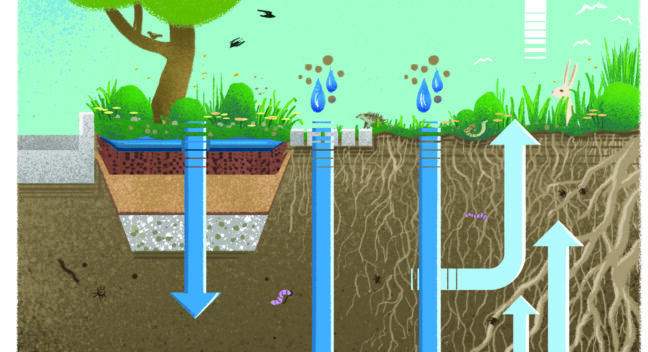Water saving and recycling


DESCRIPTION
Longer dry periods in Europe and a decreasing trend in average precipitation have been experienced since the second half of 20th century, especially in summer and in southern areas, including the Mediterranean and the Adriatic-Ionian region (EEA, 2017 indicator assessment of precipitation) leading to occasional water shortages. In addition, the increase of temperature projected across all of Europe is likely to create an increasing demand for the resource for different uses such as cooling, drinking, irrigation, etc.
Water saving and recycling option includes various alternative or complementary measures having the general objective of saving water resource, encouraging a more conscious and efficient use of water, especially in the perspective of important challenges posed by climate change. This option includes water restrictions, rationing and consumption cut initiatives to limit water use; re-use of water for not-for-drinking uses; installation of water saving devices; rehabilitation of ageing water distribution network; economic incentives and awareness-raising initiatives.
Water restrictions aim at regulating water distribution so that it is provided only for essential uses (excluding, for example, lawn watering and swimming pool filling), while water rationing usually includes temporary suspension of water supply, or reduction of pressure below that required for adequate supply under normal conditions. These measures can have a permanent or temporary character and are applied especially in the case of acute water scarcity due to seasonal dynamics or to exceptionally dry periods. They are generally considered effective in reducing the water demand in the short term, while they can be less effective in the long term, if not complemented with other measures.
The use of alternative sources of water (e.g. rainwater harvesting) and wastewater recycling for non-drinking purposes can be options to allow regular water supply in areas where the resource is limited. Rainwater harvesting is the accumulation and storage of rainwater for its reuse on-site, while recycling typically re-uses wastewater from domestic use (laundry, showering, sinks). Recycled or stored water can be re-used in agriculture, gardening or industrial applications. Though re-use is covered by European legislation and policy (e.g. the Urban Waste Water Directive and the Water Scarcity and Drought policy), safety issues and a lack of internationally recognised standards are often felt as an obstacle to a more effective implementation.
Water saving devices and metering systems of water consumption are key tools to limit water use. Well-known household appliances include toilets, showers, taps, washing machines and dishwashers. The “Eco-design” European Directive (2009/125/EC) can give a positive impulse to the design of these systems, to reduce consumption of both energy and water.
Reducing water losses in water infrastructure is a central task for water saving, especially considering that losses in the drinking water network can represent a considerable percentage of the volume initially produced, with situations widely different among the European countries. Measures include regular maintenance of the network, identification and measurement of water losses and reparation or replacement of obsolete infrastructure.
Finally, economic incentives or differentiated tariff systems for water supply can encourage the adoption of water saving systems, while awareness-raising and informative campaigns can have a major role towards a wide behavioural change, especially in the case of household consumption.
COSTS AND BENEFITS
The general benefit of this option is the overall safeguard of the natural water resources through the reduction of its use and maximisation of the re-use potential. Both approaches have a positive effect on the rationalisation of use of water resource, allowing for adapting to the challenges posed by climate changes, such as water scarcity and droughts.
According to a study aimed to estimate EU water saving potential (Dworak et al., 2007), the reduction of leakage in water supply networks, the adoption of water saving devices and the adoption of more efficient household appliances have a potential for up to 50% water savings, with a reduction of water consumption up to 150 l per person per day.
Other benefits of water-saving and recycling initiatives include energy saving and cost saving owing to the avoidance of the operation of expensive and high energy consuming desalination plants in areas and/or periods of water scarcity.
Compulsory water restrictions and rationing, producing significant water savings in a short time, can avoid the set-up of other alternative measures based on water pricing, producing a clear economic advantage for the users. While household water saving devices are generally simple and cheap to install, large investments are required for network monitoring, maintenance and rehabilitation that are also technically challenging. In this case, costs clearly depend on the age of the network, on the typology of programmed interventions and on the selected monitoring technology. Utilities distributing water from expensive sources (such as desalination) can justify increased leakage control activity compared to those using cheaper sources. In case of recycling wastewater or using rain harvesting, the cost of recycled water may exceed that of non-recycled water, but it is in general compensated by the provided benefits. Incentives or subsidies to use these systems can encourage private investments, overcoming the barrier of costs.
IMPLEMENTATION TIME AND LIFETIME
Restriction and rationing of water are generally temporary actions that can be quickly set up and have a duration of days or months (for example during the dry summer period), mainly whenever they are established to counteract acute crises of water scarcity. Compulsory water restrictions can produce significant water savings in a short time.
Water-reuse and recycling systems generally require more time to be designed and set up, but they have a longer lifetime (up to more than 25 years).
The most complex measures are those of the maintenance and repairing of distribution networks to avoid leakages. Monitoring activities are part of a continuous process, while repairing and replacement of old pipes follow the infrastructure lifetime.
SOURCE FOR MORE DETAILED INFORMATION
https://www.eea.europa.eu/signals/signals-2018-content-list/articles/water-use-in-europe-2014
https://www.eea.europa.eu/themes/water/european-waters/water-management/water-management-in-europe
https://unesdoc.unesco.org/ark:/48223/pf0000247153
Dworak, T., M. Berglund, C. Laaser, P. Strosser, J. Roussard, B. Grandmougin, M. Kossida, et al. 2007. “EU Water Saving Potential (Part 1 — Report).” Report ENV.D.2/ETU/2007/0001r. Berlin: Ecologic. https://www.ecologic.eu/sites/files/download/projekte/900-949/917/917_water_saving_1.pdf
